现代语言学学习笔记.
- 格式:doc
- 大小:334.01 KB
- 文档页数:57
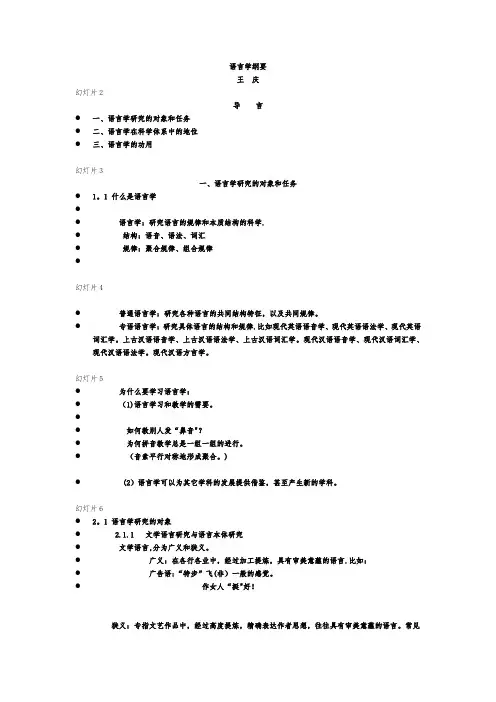
语言学纲要王庆幻灯片2导言●一、语言学研究的对象和任务●二、语言学在科学体系中的地位●三、语言学的功用幻灯片3一、语言学研究的对象和任务●1。
1 什么是语言学●●语言学:研究语言的规律和本质结构的科学.●结构:语音、语法、词汇●规律:聚合规律、组合规律●幻灯片4●普通语言学:研究各种语言的共同结构特征,以及共同规律。
●专语语言学:研究具体语言的结构和规律.比如现代英语语音学、现代英语语法学、现代英语词汇学。
上古汉语语音学、上古汉语语法学、上古汉语词汇学。
现代汉语语音学、现代汉语词汇学、现代汉语语法学。
现代汉语方言学。
幻灯片5●为什么要学习语言学:●(1)语言学习和教学的需要。
●●如何教别人发“鼻音"?●为何拼音教学总是一组一组的进行。
●(音素平行对称地形成聚合。
)● (2)语言学可以为其它学科的发展提供借鉴,甚至产生新的学科。
幻灯片6●2。
1 语言学研究的对象● 2.1.1 文学语言研究与语言本体研究●文学语言,分为广义和狭义。
●广义:在各行各业中,经过加工提炼,具有审美意蕴的语言.比如:●广告语:“特步”飞(非)一般的感觉。
●作女人“挺"好!狭义:专指文艺作品中,经过高度提炼,精确表达作者思想,往往具有审美意蕴的语言。
常见的诗歌、小说、散文、论文等。
●如《天净沙·秋思》。
●●文学语言研究,主要是指语言运用研究,探讨语言与思想情感表达的关系、语言与审美(比如意境)表达的关系。
●语言本体的研究和文学语言的研究不同:● 1、语言学研究所有语言的共性的、本质的结构和规律.●文学语言研究语言的表达,即语言如何完美地表达了作者的思想和意图。
●●语言学研究语言为什么能够让人交流。
●文学语言研究语言怎样完美地实现了表达。
● 2、语言学不研究语言的审美意蕴。
●文学语言的重点是研究语言的审美意蕴。
●从历时来看,语言学研究的对象有两个:古代书面语和现代活语言● 2。
1.2 语文学●研究对象:古代书面语●研究目的:为经典作注(语文学)●三大语言学的发源地的语文学研究:●希腊—-罗马:拉丁文●语法、修辞、逻辑●印度:梵语●语音、语法●中国:文言文●小学:音韵、训诂(文字)“小学”:最初指“小孩入学的地方”.●“及太子少长知色则入于小学,小学者所学之宫也.……古者八岁而就外舍,学小艺焉,履小节焉。
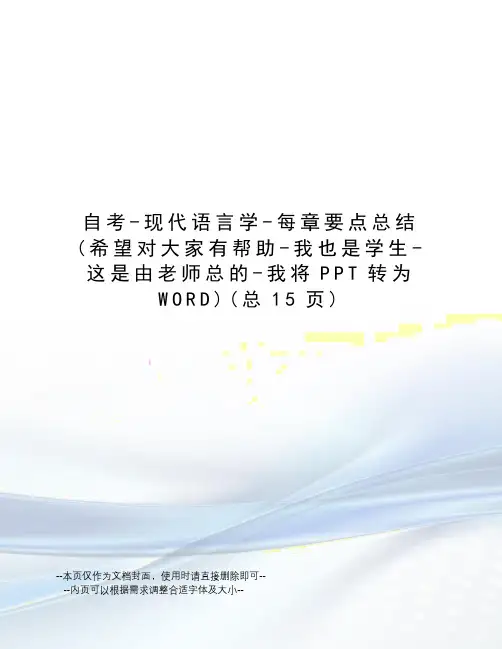
自考-现代语言学-每章要点总结(希望对大家有帮助-我也是学生-这是由老师总的-我将P P T转为W O R D)(总15页)--本页仅作为文档封面,使用时请直接删除即可----内页可以根据需求调整合适字体及大小--第一章绪论1/ What is linguistics 什么是语言学?Linguistics is generally defined as the scientific study of language. It studies not any particular language, but languages in general. 2/ The scope oflinguistics语言学的研究范畴The study of language as a whole is oftencalled general linguistics. (普通语言学)The study of sounds, which are used inlinguistic communication, is called phonetics. (语音学)The study of how sounds are put together and used in communication is called phonology. (音系学)The study of the way in which morphemes are arranged to form words are called morphology. (形态学)The study of how morphemes and words are combined to form sentences is called syntax. (句法学)The study of meaning in language iscalled semantics. (语义学)The study of meaning in context of use iscalled pragmatics. (语用学)The study of language with reference to society is called socio-linguistics. (社会语言学)The study of language with reference to the working of mind is called psycho-linguistics. (心理recovery of speech ability)is generally knownas applied linguistics.(应用语言学)But in a narrow sense,applied linguistics refersto the application oflinguistic principles andtheories to languageteaching and learning,especially the teaching offoreign and secondlanguage.Other related branchesinclude anthropologicallinguistics, (人类语言学)neurologicallinguistics, (神经语言学)mathematicallinguistics, (数字语言学)and computationallinguistics. (计算机语言学)3/ Some importantdistinctions inlinguistics语言学研究中的几对基本概念Prescriptive anddescriptive描写与规定If a linguistic studydescribes and analyzes thelanguage people actuallyuse, it is said tobe descriptive, if itaims to lay down rules totell people what theyshould say and what theyshould not say, it is saidto be prescriptive.Modern linguisticsdiffers from traditionalgrammar.Traditional grammar isprescriptive while modernlinguistics is descriptive.The task of linguists issupposed to describe thelanguage people actuallyuse, whether it is“correct” or not.Synchronic and diachronic共时和历时The description of alanguage at some point ina diachronic study. Inmodern linguistics,synchronic study is moreimportant.Speech and writing口头语与书面语Speech and writing arethe two major media ofcommunication.Modern linguisticsregards the spoken form oflanguage as primary, butnot the written form.Reasons:1. Speech precedeswriting;2. There are still manylanguages that have onlythe spoken form;3. In terms of function,the spoken language isused for a wider range ofpurposes than the written,and carries a larger loadof communication than thewritten.Langue and parole[pə'rəul]语言和言语The Swiss linguist F.de Saussure made thedistinction between langueand parole early20th century.Langue refers to theabstract linguistic systemshared by all the membersof a speech community,and parole refers to therealization of langue inactual use.Saussure made thedistinction in order tosingle out one aspect oflanguage for serious study.He believes what linguistsshould do is to abstractlangue from parole, todiscover the regularitiesgoverning the actual useof language and make themthe subjects of study oflinguistics.语言能力和语言运用Competence andperformanceProposed by Americanlinguist N. Chomsky in thethe ideal user’sknowledge of the rules ofhis language,and performance theactual realization of thisknowledge in linguisticcommunication. He believesthe task of the linguistsis to discover and specifythe language rules.4/ What is language语言的定义Language is a system ofarbitrary vocal symbolsused for humancommunication.Sapir,Edward uses“ideas” “emotions” and“desires” in hisdefinition.Hall, like Sapir, treatslanguage as a purely humaninstitution.Chomsky’s definition isquite different, it focuson the purely structuralproperties of languagesand to suggest that theseproperties can beinvestigated from amathematically precisepoint of view.5/ Design features语言的甄别性特征Design features refer tothe defining properties ofhuman language thatdistinguish it from anyanimal system ofcommunication.American linguistCharles Hockett specifiedtwelve design features.1) Arbitrariness任意性(和约定俗成性)It means that there isno logical connectionbetween meanings andsounds.For instance, there is nonecessary relationshipbetween the word dog andthe animal it refers to.The fact that differentsounds are used to referto the same object indifferent languages andthat the same sound may beused to refer to differentnot entirely arbitrary. Some words, such as the words created in the imitation of sounds by sounds are motivated in a certain degree. The arbitrary nature of language makes it possible for language to have an unlimited source of expressions.2) Productivity能产性Language is productive or creative in that it makes possible the construction and interpretation of an infinitely large number of sentences, including those that they have never said or heard before.3) Duality结构二重性It means that language is a system, which consists of two sets of structure, or two levels, one of sounds at the lower level and the other of meanings at the higher level. At the lower or the basic level, there is the structure of individual and meaningless sounds, which can be grouped into meaningful units at the higher level. This duality of structure or double articulation of language enables its users to talk about anything withintheir knowledge.4) Displacement语言的移位性(突破时空性)It means that language can be used to talk about what happened in the past, what is happening now, or what will happen in the future. Language can also be used to talk about our real word experiences or the experiences in our imaginary world. In other words, language can be used to refer to contexts removed from the immediate situations of the speaker. 5) Cultural transmission文化传播性While we are born withthe ability to acquirelanguage, the details ofany language are notgenetically transmitted,but instead have to betaught and learned anew.**********************************Chapter 2Phonology 音系学phonic medium of language语言的声音媒介Speech and writing arethe two media used bynatural languages asvehicles for communication.Of the two media oflanguage, speech is morebasic than writing. Speechis prior to writing. Thewriting system of anylanguage is always“invented” by its usersto record speech when theneed arises.For linguists, the studyof sounds is of greaterimportance than that ofwriting.The limited ranges ofsounds which aremeaningful in humancommunication and are ofinterest to linguisticstudies are the phonicmedium of language (语言的声音媒介) .The individual soundswithin this range are thespeech sounds (语音).2.What is phonetics什么是语音学?Phonetics is defined asthe study of the phonicmedium of language;It isconcerned with all thesounds that occur in theworld’s languages.语音学研究的对象是语言的声音媒介,即人类语言中使用的全部语音。
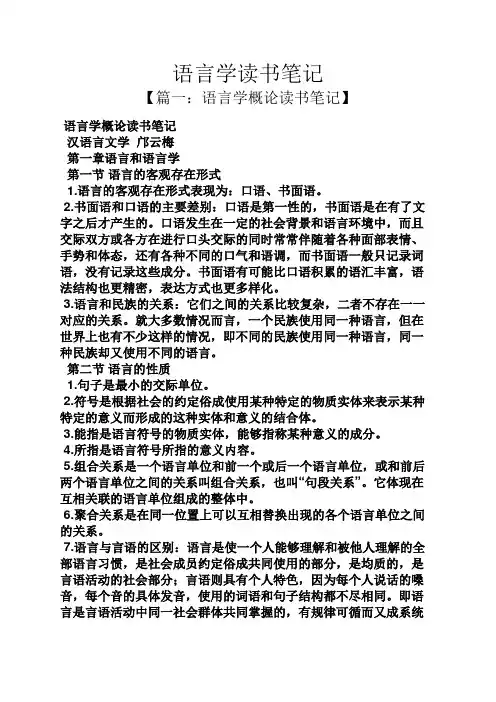
语言学读书笔记【篇一:语言学概论读书笔记】语言学概论读书笔记汉语言文学邝云梅第一章语言和语言学第一节语言的客观存在形式1.语言的客观存在形式表现为:口语、书面语。
2.书面语和口语的主要差别:口语是第一性的,书面语是在有了文字之后才产生的。
口语发生在一定的社会背景和语言环境中,而且交际双方或各方在进行口头交际的同时常常伴随着各种面部表情、手势和体态,还有各种不同的口气和语调,而书面语一般只记录词语,没有记录这些成分。
书面语有可能比口语积累的语汇丰富,语法结构也更精密,表达方式也更多样化。
3.语言和民族的关系:它们之间的关系比较复杂,二者不存在一一对应的关系。
就大多数情况而言,一个民族使用同一种语言,但在世界上也有不少这样的情况,即不同的民族使用同一种语言,同一种民族却又使用不同的语言。
第二节语言的性质1.句子是最小的交际单位。
2.符号是根据社会的约定俗成使用某种特定的物质实体来表示某种特定的意义而形成的这种实体和意义的结合体。
3.能指是语言符号的物质实体,能够指称某种意义的成分。
4.所指是语言符号所指的意义内容。
5.组合关系是一个语言单位和前一个或后一个语言单位,或和前后两个语言单位之间的关系叫组合关系,也叫“句段关系”。
它体现在互相关联的语言单位组成的整体中。
6.聚合关系是在同一位置上可以互相替换出现的各个语言单位之间的关系。
7.语言与言语的区别:语言是使一个人能够理解和被他人理解的全部语言习惯,是社会成员约定俗成共同使用的部分,是均质的,是言语活动的社会部分;言语则具有个人特色,因为每个人说话的嗓音,每个音的具体发音,使用的词语和句子结构都不尽相同。
即语言是言语活动中同一社会群体共同掌握的,有规律可循而又成系统的那一部分;而含有个人要素或个人杂质的说话行为和说出来的话(包括写出来的“话”)只能属于言语。
8.语言符号的特征:任意性、强制性与可变性。
人们最初创制单个的语言符号时,用什么样的形式——语音与什么样的内容——语义相结合,并没有什么必然性,而带有很大的偶然性或随意性。
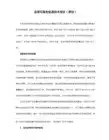
胡壮麟语言学笔记无私分享(全)《语言学教程》重难点学习提示第一章??语言的性质语言的定义:语言的基本特征(任意性、二重性、多产性、移位、文化传递和互换性);语言的功能(寒暄、指令、提供信息、询问、表达主观感情、唤起对方的感情和言语行为);语言的起源(神授说,人造说,进化说)等。
第二章? ?? ?语言学语言学定义;研究语言的四大原则(穷尽、一致、简洁、客观);语言学的基本概念(口语与书面语、共时与历时、语言与言学、语言能力与言行运用、语言潜势与语言行为);普通语言学的分支(语音、音位、语法、句法、语义);;语言学的应用(语言学与语言教学、语言与社会、语言与文字、语言与心理学、人类语言学、神经语言学、数理语言学、计算语言学)等。
第三章? ?? ?语音学发音器官的英文名称;英语辅音的发音部位和发音方法;语音学的定义;发音语音学;听觉语音学;声学语音学;元音及辅音的分类;严式与宽式标音等。
第四章? ???音位学音位理论;最小对立体;自由变异;互补分布;语音的相似性;区别性特征;超语段音位学;音节;重音(词重音、句子重音、音高和语调)等。
第五章? ? 词法学词法的定义;曲折词与派生词;构词法(合成与派生);词素的定义;词素变体;自由词素;粘着词素(词根,词缀和词干)等。
第六章? ? 词汇学词的定义;语法词与词汇词;变词与不变词;封闭词与开放词;词的辨认;习语与搭配。
第七章??句法句法的定义;句法关系;结构;成分;直接成分分析法;并列结构与从属结构;句子成分;范畴(性,数,格);一致;短语,从句,句子扩展等。
第八章? ?语义学语义的定义;语义的有关理论;意义种类(传统、功能、语用);里奇的语义分类;词汇意义关系(同义、反义、下义);句子语义关系。
第九章? ?语言变化语言的发展变化(词汇变化、语音书写文字、语法变化、语义变化);第十章??语言、思维与文化语言与文化的定义;萨丕尔-沃夫假说;语言与思维的关系;语言与文化的关系;中西文化的异同。
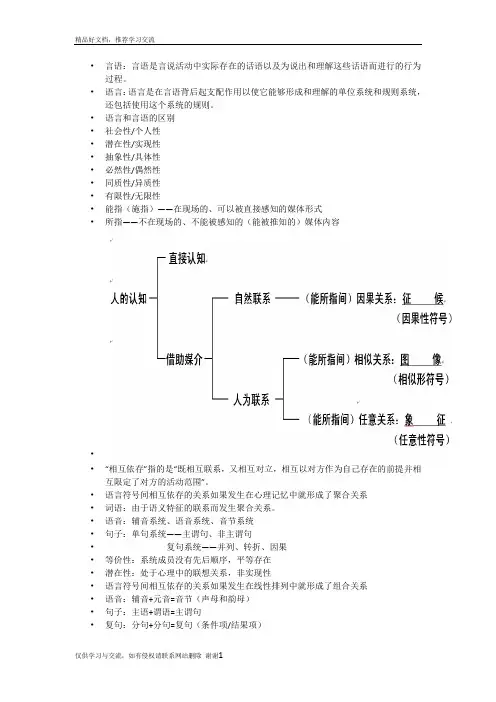
•言语:言语是言说活动中实际存在的话语以及为说出和理解这些话语而进行的行为过程。
•语言:语言是在言语背后起支配作用以使它能够形成和理解的单位系统和规则系统,还包括使用这个系统的规则。
•语言和言语的区别•社会性/个人性•潜在性/实现性•抽象性/具体性•必然性/偶然性•同质性/异质性•有限性/无限性•能指(施指)——在现场的、可以被直接感知的媒体形式•所指——不在现场的、不能被感知的(能被推知的)媒体内容••“相互依存”指的是“既相互联系,又相互对立,相互以对方作为自己存在的前提并相互限定了对方的活动范围”。
•语言符号间相互依存的关系如果发生在心理记忆中就形成了聚合关系•词语:由于语义特征的联系而发生聚合关系。
•语音:辅音系统、语音系统、音节系统•句子:单句系统——主谓句、非主谓句•复句系统——并列、转折、因果•等价性:系统成员没有先后顺序,平等存在•潜在性:处于心理中的联想关系,非实现性•语言符号间相互依存的关系如果发生在线性排列中就形成了组合关系•语音:辅音+元音=音节(声母和韵母)•句子:主语+谓语=主谓句•复句:分句+分句=复句(条件项/结果项)•顺序性:不等价,按序排列•实现性:被提取实现为具体的结构•元语言功能•元语言功能是语言指向代码系统的功能。
•语言不仅可以用来描述外部世界的客观对象,而且可以把语言本身当作外部对象一样进行描述。
•元语言与自元语言•作用:语言教学、翻译、词典等•语言在人类认知中的范型作用•语言包含了我们在认知过程中划分和组织世界时所必须的、最基本的范畴和结构方式。
•每一个词语都提供了对相应认知对象的解释方式、分类规则和有关的知识积累。
•语言上的差别促使我们更细致地观察和分析。
•音位的功能性定义•音位是某种特定语言或方言里最小的能区别语音形式和意义的语音类型单位。
•义位的功能定义•(1)义位的最大功能是对所指对象的划分和概括反映,这是词能够指称和述谓的基础。
•(2)义位的概括反映往往具有模糊性的特点,也就是概括范围没有明确的界限。
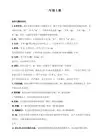
Chapter one Introduction一、定义1.语言学LinguisticsLinguistics is generally defined as the scientific study of language.2.普通语言学General LinguisticsThe study of language as a whole is often called General linguistics.3.语言languageLanguage is a system of arbitrary vocal symbols used for human communication.语言是人类用来交际的任意性的有声符号体系。
4.识别特征Design FeaturesIt refers to the defining poperties of human language that distinguish it from any animal system of communication.语言识别特征是指人类语言区别与其他任何动物的交际体系的限定性特征。
Arbitrariness任意性Productivity多产性Duality双重性Displacement移位性Cultural transmission文化传递⑴arbitrarinessThere is no logical connection between meanings and sounds.P.S the arbitrary nature of language is a sign of sophistication and it makes it possible for language to have an unlimited source of expressions⑵ProductivityAnimals are quite limited in the messages they are able to send.⑶DualityLanguage is a system, which consists of two sets of structures ,or two levels.⑷DisplacementLanguage can be used to refer to contexts removed from the immediate situations of the speaker.⑸Cultural transmissionHuman capacity for language has a genetic basis, but we have to be taught and learned the details of any language system. this showed that language is culturally transmitted. not by instinct. animals are born with the capacity to produce the set of calls peculiar to their species.5.语言能力CompetenceCompetence is the ideal user’s knowledge of the rules of his language.6.语言运用performancePerformance is the actual realization of this knowledge in linguistic communication.语言运用是所掌握的规则在语言交际中的体现。
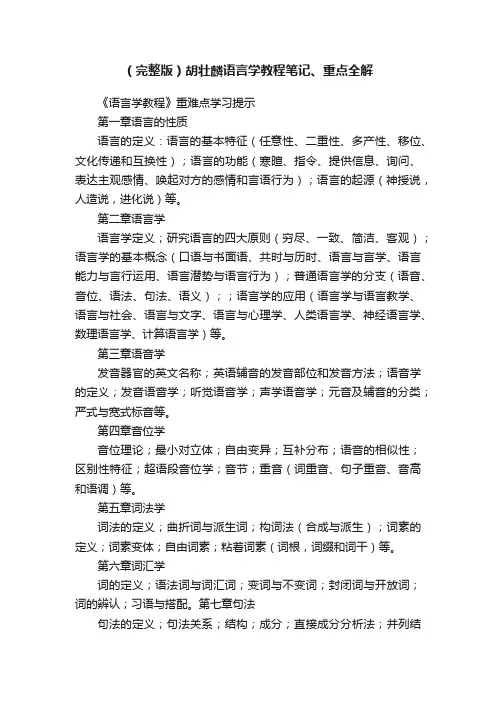
(完整版)胡壮麟语言学教程笔记、重点全解《语言学教程》重难点学习提示第一章语言的性质语言的定义:语言的基本特征(任意性、二重性、多产性、移位、文化传递和互换性);语言的功能(寒暄、指令、提供信息、询问、表达主观感情、唤起对方的感情和言语行为);语言的起源(神授说,人造说,进化说)等。
第二章语言学语言学定义;研究语言的四大原则(穷尽、一致、简洁、客观);语言学的基本概念(口语与书面语、共时与历时、语言与言学、语言能力与言行运用、语言潜势与语言行为);普通语言学的分支(语音、音位、语法、句法、语义);;语言学的应用(语言学与语言教学、语言与社会、语言与文字、语言与心理学、人类语言学、神经语言学、数理语言学、计算语言学)等。
第三章语音学发音器官的英文名称;英语辅音的发音部位和发音方法;语音学的定义;发音语音学;听觉语音学;声学语音学;元音及辅音的分类;严式与宽式标音等。
第四章音位学音位理论;最小对立体;自由变异;互补分布;语音的相似性;区别性特征;超语段音位学;音节;重音(词重音、句子重音、音高和语调)等。
第五章词法学词法的定义;曲折词与派生词;构词法(合成与派生);词素的定义;词素变体;自由词素;粘着词素(词根,词缀和词干)等。
第六章词汇学词的定义;语法词与词汇词;变词与不变词;封闭词与开放词;词的辨认;习语与搭配。
第七章句法句法的定义;句法关系;结构;成分;直接成分分析法;并列结构与从属结构;句子成分;范畴(性,数,格);一致;短语,从句,句子扩展等。
第八章语义学语义的定义;语义的有关理论;意义种类(传统、功能、语用);里奇的语义分类;词汇意义关系(同义、反义、下义);句子语义关系。
第九章语言变化语言的发展变化(词汇变化、语音书写文字、语法变化、语义变化);第十章语言、思维与文化语言与文化的定义;萨丕尔-沃夫假说;语言与思维的关系;语言与文化的关系;中西文化的异同。
第十一章语用学语用学的定义;语义学与语用学的区别;语境与意义;言语行为理论(言内行为、言外行为和言后行为);合作原则。
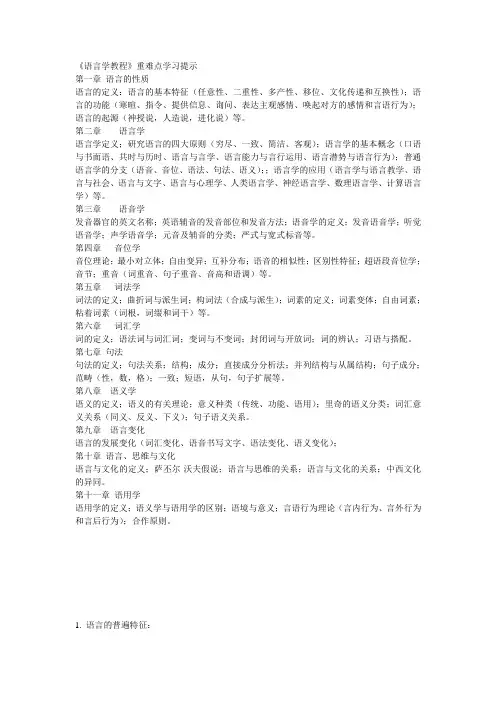
《语言学教程》重难点学习提示第一章语言的性质语言的定义:语言的基本特征(任意性、二重性、多产性、移位、文化传递和互换性);语言的功能(寒暄、指令、提供信息、询问、表达主观感情、唤起对方的感情和言语行为);语言的起源(神授说,人造说,进化说)等。
第二章语言学语言学定义;研究语言的四大原则(穷尽、一致、简洁、客观);语言学的基本概念(口语与书面语、共时与历时、语言与言学、语言能力与言行运用、语言潜势与语言行为);普通语言学的分支(语音、音位、语法、句法、语义);;语言学的应用(语言学与语言教学、语言与社会、语言与文字、语言与心理学、人类语言学、神经语言学、数理语言学、计算语言学)等。
第三章语音学发音器官的英文名称;英语辅音的发音部位和发音方法;语音学的定义;发音语音学;听觉语音学;声学语音学;元音及辅音的分类;严式与宽式标音等。
第四章音位学音位理论;最小对立体;自由变异;互补分布;语音的相似性;区别性特征;超语段音位学;音节;重音(词重音、句子重音、音高和语调)等。
第五章词法学词法的定义;曲折词与派生词;构词法(合成与派生);词素的定义;词素变体;自由词素;粘着词素(词根,词缀和词干)等。
第六章词汇学词的定义;语法词与词汇词;变词与不变词;封闭词与开放词;词的辨认;习语与搭配。
第七章句法句法的定义;句法关系;结构;成分;直接成分分析法;并列结构与从属结构;句子成分;范畴(性,数,格);一致;短语,从句,句子扩展等。
第八章语义学语义的定义;语义的有关理论;意义种类(传统、功能、语用);里奇的语义分类;词汇意义关系(同义、反义、下义);句子语义关系。
第九章语言变化语言的发展变化(词汇变化、语音书写文字、语法变化、语义变化);第十章语言、思维与文化语言与文化的定义;萨丕尔-沃夫假说;语言与思维的关系;语言与文化的关系;中西文化的异同。
第十一章语用学语用学的定义;语义学与语用学的区别;语境与意义;言语行为理论(言内行为、言外行为和言后行为);合作原则。
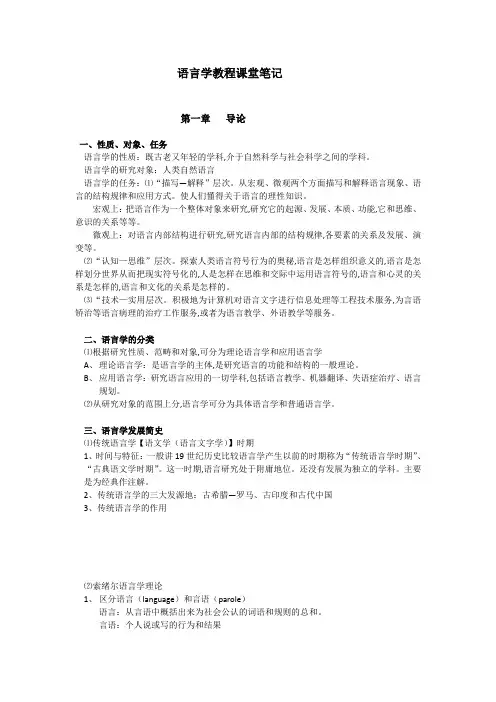
语言学教程课堂笔记第一章导论一、性质、对象、任务语言学的性质:既古老又年轻的学科,介于自然科学与社会科学之间的学科。
语言学的研究对象:人类自然语言语言学的任务:⑴“描写—解释”层次。
从宏观、微观两个方面描写和解释语言现象、语言的结构规律和应用方式。
使人们懂得关于语言的理性知识。
宏观上:把语言作为一个整体对象来研究,研究它的起源、发展、本质、功能,它和思维、意识的关系等等。
微观上:对语言内部结构进行研究,研究语言内部的结构规律,各要素的关系及发展、演变等。
⑵“认知—思维”层次。
探索人类语言符号行为的奥秘,语言是怎样组织意义的,语言是怎样划分世界从而把现实符号化的,人是怎样在思维和交际中运用语言符号的,语言和心灵的关系是怎样的,语言和文化的关系是怎样的。
⑶“技术—实用层次。
积极地为计算机对语言文字进行信息处理等工程技术服务,为言语矫治等语言病理的治疗工作服务,或者为语言教学、外语教学等服务。
二、语言学的分类⑴根据研究性质、范畴和对象,可分为理论语言学和应用语言学A、理论语言学:是语言学的主体,是研究语言的功能和结构的一般理论。
B、应用语言学:研究语言应用的一切学科,包括语言教学、机器翻译、失语症治疗、语言规划。
⑵从研究对象的范围上分,语言学可分为具体语言学和普通语言学。
三、语言学发展简史⑴传统语言学【语文学(语言文字学)】时期1、时间与特征:一般讲19世纪历史比较语言学产生以前的时期称为“传统语言学时期”、“古典语文学时期”。
这一时期,语言研究处于附庸地位。
还没有发展为独立的学科。
主要是为经典作注解。
2、传统语言学的三大发源地:古希腊—罗马、古印度和古代中国3、传统语言学的作用⑵索绪尔语言学理论1、区分语言(language)和言语(parole)语言:从言语中概括出来为社会公认的词语和规则的总和。
言语:个人说或写的行为和结果2、区别组合关系和聚合关系3、语言和言语的关系:A、一般和个别B、抽象和具体四、语言学的功能(为什么要学语言学概论)1、便与从事与语言相关的工作2、有利于语言规划、信息处理等语言应用3、便于观察语言现象、发现并解释语言规律4、便于提高发现、分析与解决问题的能力5、在语言理论的指导下,透过语言使用我们可以洞悉人类心理的奥秘,为更好地掌握和利用心智打下基础五、怎样学习语言学概论1、勤观察,培养对语言现象的敏锐洞察力2、多思考,培养强烈的问题求解意识3、三个充分:观察充分、描写充分、解释充分第二章语言的本质与起源一、语言的本质(什么是语言?)1、①(为什么)语言是人类特有的、②(为什么是)最重要的全民交际工具。
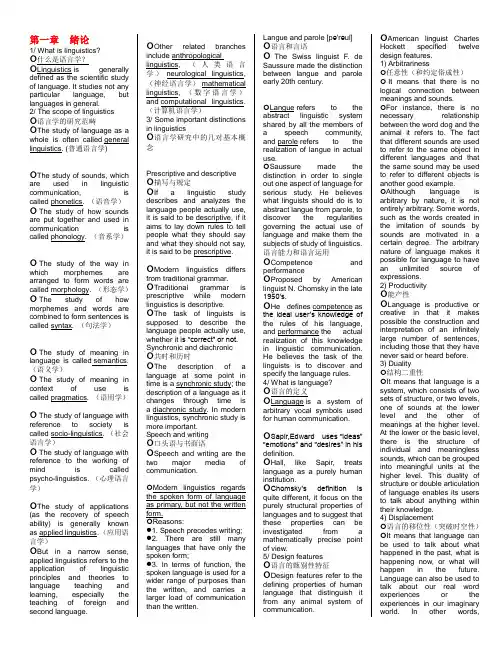
第一章绪论1/ What is linguistics?什么是语言学?Linguistics is generally defined as the scientific study of language. It studies not any particular language, but languages in general.2/ The scope of linguistics语言学的研究范畴The study of language as a whole is often called general linguistics. (普通语言学)The study of sounds, which are used in linguistic communication, is called phonetics. (语音学) The study of how sounds are put together and used in communication is called phonology. (音系学) The study of the way in which morphemes are arranged to form words are called morphology. (形态学) The study of how morphemes and words are combined to form sentences is called syntax. (句法学)The study of meaning in language is called semantics. (语义学)The study of meaning in context of use is called pragmatics. (语用学) The study of language with reference to society is called socio-linguistics. (社会语言学)The study of language with reference to the working of mind is called psycho-linguistics. (心理语言学)The study of applications (as the recovery of speech ability) is generally known as applied linguistics. (应用语言学)But in a narrow sense, applied linguistics refers to the application of linguistic principles and theories to language teaching and learning, especially the teaching of foreign and second language. Other related branchesinclude anthropologicallinguistics, (人类语言学) neurological linguistics,(神经语言学) mathematicallinguistics, (数字语言学)and computational linguistics.(计算机语言学)3/ Some important distinctionsin linguistics语言学研究中的几对基本概念Prescriptive and descriptive描写与规定If a linguistic studydescribes and analyzes thelanguage people actually use,it is said to be descriptive, if itaims to lay down rules to tellpeople what they should sayand what they should not say,it is said to be prescriptive.Modern linguistics differsfrom traditional grammar.Traditional grammar isprescriptive while modernlinguistics is descriptive.The task of linguists issupposed to describe thelanguage people actually use,whether it i s “correct” or not.Synchronic and diachronic共时和历时The description of alanguage at some point intime is a synchronic study; thedescription of a language as itchanges through time isa diachronic study. In modernlinguistics, synchronic study ismore important.Speech and writing口头语与书面语Speech and writing are thetwo major media ofcommunication.Modern linguistics regardsthe spoken form of languageas primary, but not the writtenform.Reasons:●1. Speech precedes writing;●2. There are still manylanguages that have only thespoken form;●3. In terms of function, thespoken language is used for awider range of purposes thanthe written, and carries alarger load of communicationthan the written.Langue and parole [pə'rəul]语言和言语The Swiss linguist F. deSaussure made the distinctionbetween langue and paroleearly 20th century.Langue refers to theabstract linguistic systemshared by all the members ofa speech community,and parole refers to therealization of langue in actualuse.Saussure made thedistinction in order to singleout one aspect of language forserious study. He believeswhat linguists should do is toabstract langue from parole, todiscover the regularitiesgoverning the actual use oflanguage and make them thesubjects of study of linguistics.语言能力和语言运用Competence andperformanceProposed by Americanlinguist N. Chomsky in the late1950’s.He defines competence asthe ideal user’s knowledge ofthe rules of his language,and performance the actualrealization of this knowledgein linguistic communication.He believes the task of thelinguists is to discover andspecify the language rules.4/ What is language?语言的定义Language is a system ofarbitrary vocal symbols usedfor human communication.Sapir,Edward uses “ideas”“emotions” and “desires” in hisdefinition.Hall, like Sapir, treatslanguage as a purely humaninstitution.Chomsky’s definition isquite different, it focus on thepurely structural properties oflanguages and to suggest thatthese properties can beinvestigated from amathematically precise pointof view.5/ Design features语言的甄别性特征Design features refer to thedefining properties of humanlanguage that distinguish itfrom any animal system ofcommunication.American linguist CharlesHockett specified twelvedesign features.1) Arbitrariness任意性(和约定俗成性)It means that there is nological connection betweenmeanings and sounds.For instance, there is nonecessary relationshipbetween the word dog and theanimal it refers to. The factthat different sounds are usedto refer to the same object indifferent languages and thatthe same sound may be usedto refer to different objects isanother good example.Although language isarbitrary by nature, it is notentirely arbitrary. Some words,such as the words created inthe imitation of sounds bysounds are motivated in acertain degree. The arbitrarynature of language makes itpossible for language to havean unlimited source ofexpressions.2) Productivity能产性Language is productive orcreative in that it makespossible the construction andinterpretation of an infinitelylarge number of sentences,including those that they havenever said or heard before.3) Duality结构二重性It means that language is asystem, which consists of twosets of structure, or two levels,one of sounds at the lowerlevel and the other ofmeanings at the higher level.At the lower or the basic level,there is the structure ofindividual and meaninglesssounds, which can be groupedinto meaningful units at thehigher level. This duality ofstructure or double articulationof language enables its usersto talk about anything withintheir knowledge.4) Displacement语言的移位性(突破时空性)It means that language canbe used to talk about whathappened in the past, what ishappening now, or what willhappen in the future.Language can also be used totalk about our real wordexperiences or theexperiences in our imaginaryworld. In other words,language can be used to refer to contexts removed from the immediate situations of the speaker.5) Cultural transmission文化传播性While we are born with the ability to acquire language, the details of any language are not genetically transmitted, but instead have to be taught and learned anew.********************************** Chapter 2 Phonology 音系学1.The phonic medium of language语言的声音媒介Speech and writing are the two media used by natural languages as vehicles for communication.Of the two media of language, speech is more basic than writing. Speech is prior to writing. The writing system of any language is always “invented” by its users to record speech when the need arises.For linguists, the study of sounds is of greater importance than that of writing.The limited ranges of sounds which are meaningful in human communication and are of interest to linguistic studies are the phonic medium of language (语言的声音媒介) .The individual sounds within this range are the speech sounds (语音).2.What is phonetics?什么是语音学?Phonetics is defined as the study of the phonic medium of language;It is concerned with all the sounds that occur in the world’s languages.语音学研究的对象是语言的声音媒介,即人类语言中使用的全部语音。
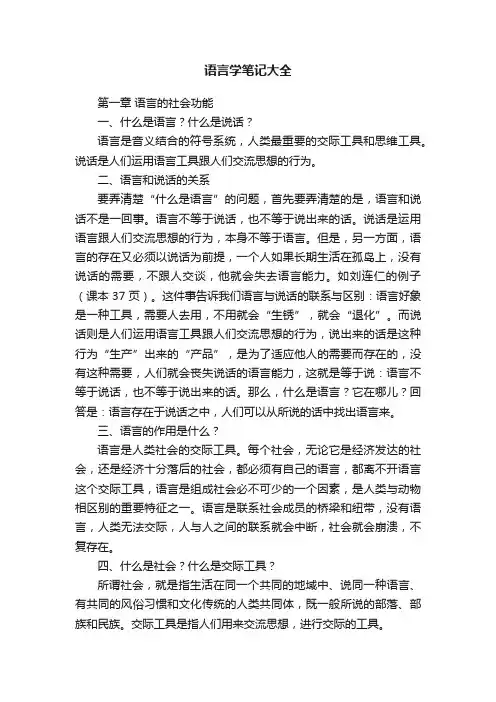
语言学笔记大全第一章语言的社会功能一、什么是语言?什么是说话?语言是音义结合的符号系统,人类最重要的交际工具和思维工具。
说话是人们运用语言工具跟人们交流思想的行为。
二、语言和说话的关系要弄清楚“什么是语言”的问题,首先要弄清楚的是,语言和说话不是一回事。
语言不等于说话,也不等于说出来的话。
说话是运用语言跟人们交流思想的行为,本身不等于语言。
但是,另一方面,语言的存在又必须以说话为前提,一个人如果长期生活在孤岛上,没有说话的需要,不跟人交谈,他就会失去语言能力。
如刘连仁的例子(课本37页)。
这件事告诉我们语言与说话的联系与区别:语言好象是一种工具,需要人去用,不用就会“生锈”,就会“退化”。
而说话则是人们运用语言工具跟人们交流思想的行为,说出来的话是这种行为“生产”出来的“产品”,是为了适应他人的需要而存在的,没有这种需要,人们就会丧失说话的语言能力,这就是等于说:语言不等于说话,也不等于说出来的话。
那么,什么是语言?它在哪儿?回答是:语言存在于说话之中,人们可以从所说的话中找出语言来。
三、语言的作用是什么?语言是人类社会的交际工具。
每个社会,无论它是经济发达的社会,还是经济十分落后的社会,都必须有自己的语言,都离不开语言这个交际工具,语言是组成社会必不可少的一个因素,是人类与动物相区别的重要特征之一。
语言是联系社会成员的桥梁和纽带,没有语言,人类无法交际,人与人之间的联系就会中断,社会就会崩溃,不复存在。
四、什么是社会?什么是交际工具?所谓社会,就是指生活在同一个共同的地域中、说同一种语言、有共同的风俗习惯和文化传统的人类共同体,既一般所说的部落、部族和民族。
交际工具是指人们用来交流思想,进行交际的工具。
五、为什么说语言是人类最重要的交际工具?人们在进行社会交际的时候,除了运用语言传递信息外,也可以借助其他手段传递信息,表达思想。
比如运动场上,篮球教练用手势表示谁犯规、谁发球等内容,不用语言;部队用长短不同的号声表示起床、集合、冲锋、撤退等信息;在海上,船与船之间用旗语传递信息等等。
第1篇第一章:语言学概述1. 语言学是一门研究语言的本质、结构、功能及其发展变化的科学。
2. 语言是人类特有的符号系统,用于表达思想、传递信息、交流感情。
3. 语言学的研究对象包括语音、词汇、语法、语义、语用、方言、标准语等。
4. 语言学的研究方法有观察法、实验法、比较法、历史法、结构主义法等。
第二章:语音学1. 语音是语言的声音现象,是语言的物质外壳。
2. 语音学是研究语音的学科,包括语音的物理属性、生理属性、心理属性和社会属性。
3. 语音的分类:元音、辅音、声调、韵律。
4. 语音的物理属性:音高、音强、音长、音质。
5. 语音的生理属性:发音器官、发音过程。
6. 语音的心理属性:语音感知、语音记忆、语音识别。
第三章:词汇学1. 词汇是语言的基本组成部分,是语言的建筑材料。
2. 词汇学是研究词汇的学科,包括词汇的来源、分类、演变、语义等。
3. 词汇的分类:基本词汇、一般词汇、专业词汇、外来词汇。
4. 词汇的来源:固有词、借词、新词。
5. 词汇的演变:词义演变、词形演变、词法演变。
6. 词汇的语义:词义、词义场、语义场。
第四章:语法学1. 语法是语言的规律,是语言的结构规则。
2. 语法学是研究语法的学科,包括词法、句法、语篇法。
3. 词法:词的构成、词的分类、词的语法功能。
4. 句法:句子的结构、句子的成分、句子的类型。
5. 语篇法:语篇的结构、语篇的连贯性、语篇的衔接。
第五章:语义学1. 语义是语言的意义,是语言符号所表示的概念。
2. 语义学是研究语义的学科,包括语义的分类、语义的关系、语义的变化。
3. 语义的分类:概念语义、语用语义、社会语义。
4. 语义的关系:同义、反义、多义、歧义。
5. 语义的变化:词义演变、语义场演变。
第六章:语用学1. 语用学是研究语言在具体语境中的运用和功能的学科。
2. 语用学的核心问题是“意义”,即语言在实际运用中的意义。
3. 语用学的研究内容:语境、语用规则、语用失误、语用策略。
语言学教程第五版重点笔记语言学是研究语言的科学,它涉及到语言的结构、发展、使用和功能等方面。
本篇笔记将重点总结语言学教程第五版的内容,包括语言学的基本概念、语音学、形态学、句法学、语义学和语用学等。
1.语言学的基本概念-语言:人类沟通的主要方式,具有符号性、规则性和交际性。
-语言的属性:可描述为音、形、意的体系,通过语音、文字等媒介来传递信息。
-语言与方言:方言是指在某个地区或群体中使用的语言变体,而语言是方言的高级别组织。
-语言的历史演变:语言随着时间推移会发生变化,并分化成不同的语言家族和亚族。
2.语音学-语音:语言中最小的语言单位,由音素构成。
-音位和音素:音位是在特定语言中具有区别词义的最小音段,而音素是语音学上对音位的理论概念。
-发音:语音的实际发声过程,包括发音器官的运动和声带的振动。
-音系:特定语言中的音位组合,反映了该语言中的音素系统。
3.形态学-形态:语言中用来构成词的基本单位。
-词的形态结构:词根、词缀和词尾等构成词的部分。
-词的形态类型:自由词和词素词。
-词类:词根或词素所属的语法类别,如名词、动词、形容词等。
4.句法学-句子:语言中最小的完整意义单位。
-短语:句子的组成部分,由词汇构成。
-句法关系:短语之间的语法关系,如主谓关系、动宾关系等。
-句法结构:句子的组织方式,包括短语结构和依存结构。
5.语义学-语义:语言中词、短语和句子所表达的意义。
-词义学:研究词汇的意义,包括词义分类、词义变化等。
-句义学:研究句子的意义,包括句子的真值条件、逻辑关系等。
6.语用学-语用:语言使用的实际情境。
-言外之意:在语言表面之下所包含的意义。
-会话分析:研究对话和交际行为的学科。
以上是《语言学教程》第五版的重点内容。
通过学习这些知识,我们可以更深入地了解语言的结构和使用规律,从而更好地理解和运用语言。
语言学教程笔记第一章语言学导论语言的定义特征:从本质上将人类语言与动物语言区分开的人类语言的区别性特点。
1•任意性:任意性是指语言符号的形式与所表示的意义没有天然的联系,任意性是语言的核心特征。
例如,我们无法解释为什么一本书读作 a /buk/,一支钢笔读作a /pen/。
任意性具有不同层次:(1)语素音义关系的任意性。
(2)句法层面上的任意性。
(3)任意性和规约性。
2•二层性:二层性是指拥有两层结构的这种特性,上层结构的单位由底层结构的元素构成,每层都有自身的组合规则。
话语的组成元素是本身不传达意义的语音,语音的唯一作用就是相互组合构成有意义的单位,比如词。
因为底层单位是无意的,而上层单位有明确的意义,所以我们把语音叫做底层单位,与词等上层单位相对。
二层性使语言拥有了一种强大的能产性。
3.创造性:创造性指语言的能产性,指语言有制造无穷长句的潜力,这来源于语言的二层性和递归性。
利用二重性说话者可以通过组合基本语言单位,无止境地生成句子,大多数都是以前没有过的或没有听过的。
4.移位性:是指人类语言可以让使用者在交际时用语言符号代表时间上和空间上并不可及的物体、时间或观点。
因此我们可以提及孔子或北极,虽然前者已经去世两千五百五十多年而后者位置距我们非常之远。
语言使我们能够谈及已不存在或还未出现的事物。
移位性赋予人们的概括与抽象能力使人类受益无穷。
词在指称具体物体时,并不总是出现在即时、形象化的语境中。
他们通常为了体现指称含义而被使用。
5.文化传递性:语言不是靠遗传,而是通过文化传递的。
6.互换性:指人可以是信息的发出者,也可以是信息的接受者,即人作为说话者和听话者的角色是可以随意更换的。
元语言功能:我们的语言可以用来讨论语言本身。
比如说,我可以用“书”指代一本书,也可以用“书这个词”来指代“书”这个词本身。
这使语言具有无限的自我反身性:人类可以谈论"说话”,也可以思考"思考"。
Chapter 12 Theories and Schools of Modern Linguistics 常考点:各学派的代表人物、理论基础、特点、主要观点、重要概念;语言普遍性和人类行为的关系。
1. 索绪尔和现代语言学1.1. 观点语言是用声音表达交流思想的符号系统;符号是形式和意义的结合;符号是语言事实的核心。
1.2. 概念能指&所指语言&言语共时研究&历时研究2. 布拉格学派2.1. 代表人物V. Mathesius---Firbas2.2. 主要观点和贡献①强调共时研究的合理性,因为它可以提供完整且易掌控的研究材料。
②强调语言的系统性,语言单位处于功能对比、对立之中。
③它将语言看作是在所属语言群体中发挥一系列功能的工具。
2.3. 功能句子观(FSP)功能句子观是一套语言学分析理论,它是指用信息论的原理来分析话语或文本。
其基本原则就是一句话中各部分起的作用取决于它对全句意义的贡献。
2.4. 主位&述位主位:话语的出发点,它是说话人和听话人都知道的信息。
述位:话语的目的,是说话人要向听话人传递的信息。
2.5. 交际能力(communicative dynamism)费尔巴斯用交际能力表示句子成分对交际发展所起的作用。
他把功能句子观解释为不同程度的交际力的分布。
3. 伦敦学派3.1. 代表人物B. Malinovski---Firth---M. A. K. Halliday3.2. B. Malinovski 的理论①语言是一种行为模式。
②话语意义来源于话语发生的上下义之间的关系。
3.3. Firth的理论弗斯认为语言是种社会过程。
语言是参与社会生活的工具,是自己做事和使他人做事的手段,是一种行为和生活手段。
3.4. M. A. K. Halliday与系统-功能语法韩礼德的系统-功能语法是一种具有社会学倾向的功能语言学方法。
①系统语法系统就是存在于语法中的一系列选择。
语言学知识点总结语言学是一门研究语言的科学,它涵盖了语言的各个方面,包括语言的结构、语言的使用、语言的发展以及语言与社会和文化的关系等。
以下是对一些重要语言学知识点的总结。
一、语音学语音学研究语音的产生、传播和感知。
其中包括元音和辅音的分类、发音部位和发音方法。
例如,元音根据舌头的位置和嘴唇的形状可以分为前元音、中元音和后元音;辅音则可以按照发音方式(如爆破音、摩擦音、鼻音等)和发音部位(如双唇音、齿龈音、软腭音等)进行分类。
在语音学中,还有国际音标这一重要工具,它为准确记录和描述各种语言的语音提供了标准。
二、音系学音系学关注的是语言中语音的系统和模式。
比如,音位是能够区别意义的最小语音单位,音位变体则是同一音位在不同环境中的不同表现形式。
不同语言的音系规则也各不相同。
有些语言可能有复杂的声调系统,而有些语言则更注重辅音和元音的组合规律。
三、形态学形态学研究词的内部结构和构词规则。
词素是形态学的基本单位,包括词根、词缀(前缀、后缀、中缀)等。
通过词素的组合和变化,可以形成不同的词形,表达不同的语法意义。
例如,在英语中,“un”“ness”等都是常见的词缀,“happy”加上“un”变成“unhappy”,“happy”加上“ness”变成“happiness”。
四、句法学句法学探讨句子的结构和组成规则。
句子可以分为简单句、复合句和复杂句。
不同的语言在句法结构上存在差异。
比如,有些语言是主语在前,谓语在后;而有些语言的语序则更加灵活。
句法规则还包括短语结构规则、句子成分(主语、谓语、宾语等)的搭配等。
五、语义学语义学关注语言符号(词、短语、句子等)与它们所指称的对象或概念之间的关系。
词汇语义学研究词的意义,包括词汇的多义性、同义关系、反义关系等。
句子语义学则研究句子的意义,包括语义的真值条件、语义的组合性等。
六、语用学语用学研究语言在实际使用中的语境和意义。
它关注语言使用者如何通过语言来实现交际目的,以及语言的理解和解释如何依赖于语境。
现代语言学学习笔记 第一章、绪论Introduction 1、语言学的主要分支是什么。每个分支的研究对象是什么? Linguistics mainly involves the following branches: General linguistics, which is the study of language as a whole and which deals with the basic concepts, theories, descriptions, models and methods applicable in any linguistic study Phonetics, which studies the sounds that are used in linguistic communication Phonology, which studies how sounds are put together and used in communication Morphology, which studies the way in which morphemes are arranged to form words Syntax, which studies how morphemes and words are combined to form sentences Semantics, which is the study of meaning in language. Pragmatics, which is the study of meaning not in isolation, but in context of use Sociolinguistics, which is the study of language with reference to society Psycholinguistics, which is the study of language with reference to the workings of mind. Applied linguistics, which is concerned about the application of linguistic findings in linguistic studies; In a narrow sense, applied linguistics refers to the application of linguistic principles and theories to language teaching and learning, especially the teaching of foreign and second languages. Other related branches are anthropological linguistics, neurological linguistics, mathematical linguistics, and computational linguistics. 2、 现代语言学与传统语法有什么区别? Traditional grammar is prescriptive; it is based on "high "(religious, literary) written language . It sets models for language users to follow. But Modern linguistics is descriptive; its investigations are based on authentic, and mainly spoken language data. It is supposed to be scientific and objective and the task of linguists is supposed to describe the language people actually use, whether it is "correct" or not. 3、什么叫共时研究?什么叫历时研究? The description of a language at some point in time is a Synchronic study; the description of a language as it changes through time is a diachronic study. A synchronic study of language describes a language as it is at some particular point in rime, while a diachronic study of language is a historical study; it studies the historical development of language over a period of time. 4、人类语言的甄别性特征是什么? 1) Arbitrariness 。 It means that there is no logical connection between meanings and sounds. For instance, there is no necessary relationship between the word dog and the animal it refers to. The fact that different sounds are used to refer to the same object in different languages and that the same sound may be used to refer to different objects is another good example. Although language is arbitrary by nature, it is not entirely arbitrary. Some words, such as the words created in the imitation of sounds by sounds are motivated in a certain degree. The arbitrary nature of language makes it possible for language to have an unlimited source of expressions. 2) Productivity 。Language is productive or creative in that it makes possible the construction and interpretation of an infinitely large number of sentences, including those that they have never said or heard before. 3) Duality 。It means that language is a system, which consists of two sets of structure, or two levels, one of sounds at the lower level and the other of meanings at the higher level. At the lower or the basic level, there is the structure of individual and meaningless sounds, which can be grouped into meaningful units at the higher level. This duality of structure or double articulation of language enables its users to talk about anything within their knowledge. 4) Displacement 。It means that language can be used to talk about what happened in the past, what is happening now, or what will happen in the future. Language can also be used to talk about our real word experiences or the experiences in our imaginary world. In other words, language can be used to refer to contexts removed from the immediate situations of the speaker. 5) Cultural transmission 。While we are born with the ability to acquire language, the details of any language are not genetically transmitted, but instead have to be taught and learned anew. 5、 Chomsky的语言能力和语言使用各指什么? American linguist N. Chomsky in the late 1950’s proposed the distinction between competence and performance. Chomsky defines competence as the ideal user’s knowledge of the rules of his language. This internalized set of rules enables the language user to produce and understand an infinitely large number of sentences and recognize sentences that are ungrammatical and ambiguous. According to Chomsky, performance is the actual realization of this knowledge in linguistic communication. Although the speaker’s knowledge of his mother tongue is perfect, his performances may have mistakes because of social and psychological factors such as stress, embarrassment, etc.. Chomsky believes that what linguists should study is the competence, which is systematic, not the performance, which is too haphazard. 6、 Saussure 是如何区分语言和言语的? The distinction between langue, and parole was made by the famous Swiss linguist Ferdinand de Saussure early this century. Langue and parole are French words. Langue refers to the abstract linguistic system shared by all the members of a speech community, and parole refers to the realization of langue in actual use. Langue is the set of conventions and rules which language users all have to follow while parole is the concrete use of the conventions and the application of the rules. Langue is abstract; It is not the language people actually use, but parole is concrete; it refers to the naturally occurring language events. Langue is relatively stable, it does not change frequently; while parole varies from person to person, and from situation to situation. 7、什么是语言学? Linguistics is generally defined as the scientific study of language. It studies not any particular language, but languages in general. 8、口头语与书面语 Speech enjoys priority over writing in modern linguistics study for the following